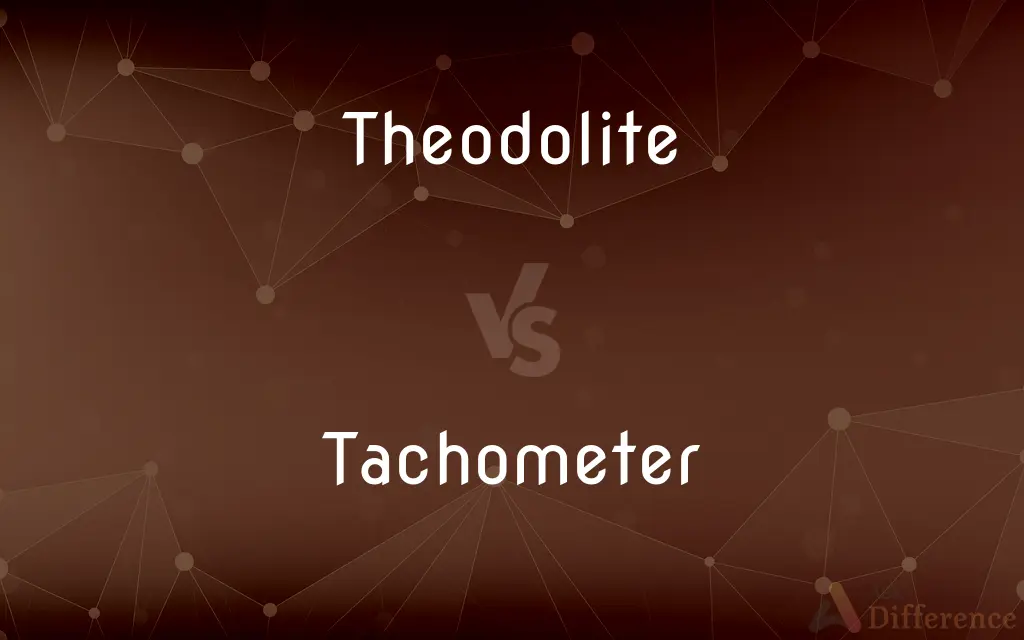Theodolite vs. Tachometer — What's the Difference?
Edited by Tayyaba Rehman — By Fiza Rafique — Updated on March 11, 2024
A theodolite measures horizontal and vertical angles for surveying, while a tachometer measures the rotation speed of an object.

Difference Between Theodolite and Tachometer
Table of Contents
ADVERTISEMENT
Key Differences
A theodolite is a precision instrument used in surveying and engineering to measure horizontal and vertical angles, crucial for establishing points on a terrain or for guiding construction. It consists of a movable telescope mounted on a base, allowing for precise measurements. Whereas a tachometer is an instrument designed to measure the rotation speed of an object, typically expressed in revolutions per minute (RPM). It is widely used in automotive, industrial, and aerospace applications to ensure the optimal performance of engines and machinery.
The operation of a theodolite involves aligning its telescope with specific points and reading the angles from its scales. This process requires a stable setup, usually on a tripod, and may include optical or electronic aids to increase accuracy. On the other hand, tachometers operate by either contacting the rotating object with a mechanical sensor or using non-contact methods such as infrared sensors or laser beams. This flexibility allows them to measure speed in a variety of settings without interfering with the operation of the equipment.
Theodolites are fundamental in topographic surveys, construction projects, and even in the alignment of heavy machinery, where precision in angles can dictate the success of a project. They are also used in meteorology and rocket launching. Tachometers, however, are essential in monitoring and troubleshooting engines and rotating machinery, helping in the maintenance of cars, airplanes, industrial equipment, and even in household appliances, ensuring they operate within safe speed limits.
While theodolites contribute to the accuracy of physical space measurements and are thus a cornerstone in civil engineering and architecture, tachometers play a critical role in the maintenance of mechanical systems, focusing on the health and efficiency of engines and rotating parts. The precision of a theodolite's angle measurements can determine the layout of vast projects, while the speed readings from a tachometer can prevent mechanical failures and extend the life of machinery.
In terms of technological complexity, modern theodolites, especially electronic ones, incorporate sophisticated software to process measurements, interface with GPS systems, and store data for further analysis. Modern tachometers also have advanced, with digital models providing real-time data logging, wireless transmission, and integration with diagnostic systems to optimize performance and safety in machinery operation.
ADVERTISEMENT
Comparison Chart
Primary Use
Measuring horizontal and vertical angles
Measuring rotation speed
Operation
Aligning telescope, reading angles
Contacting or non-contacting speed measurement
Applications
Surveying, construction, meteorology
Automotive, industrial, aerospace
Importance
Precision in physical space layout
Engine and machinery maintenance
Technology
Optical/electronic aids, GPS integration
Digital, real-time data logging, wireless
Compare with Definitions
Theodolite
Incorporates electronic aids for precision.
The modern theodolite connects to GPS to enhance the accuracy of its measurements.
Tachometer
Features like data logging and wireless transmission.
The digital tachometer transmitted real-time speed data to the control system for monitoring.
Theodolite
Essential for accurate land surveying and mapping.
Before the building design could be finalized, the theodolite helped map out the terrain's contours.
Tachometer
Helps maintain equipment at safe operating speeds.
The factory's maintenance team used tachometers to prevent machinery from overheating.
Theodolite
A precision optical instrument for measuring angles in the horizontal and vertical planes.
The surveyor used a theodolite to determine the boundary lines for the new construction site.
Tachometer
An instrument measuring the rotation speed of a shaft or disk, as in a motor or other machine.
The mechanic checked the engine's RPM using a handheld tachometer.
Theodolite
Guides the construction of buildings and infrastructure.
Engineers relied on the theodolite to ensure the bridge's piers were perfectly aligned.
Tachometer
Critical for monitoring car engine performance.
During the tune-up, the tachometer readings helped adjust the engine for optimal performance.
Theodolite
Used in civil engineering and surveying courses.
Students practiced with a theodolite to learn the basics of topographic surveying.
Tachometer
Uses laser or infrared for safe speed checks.
To avoid disrupting the machinery, a non-contact tachometer measured the conveyor belt's speed.
Theodolite
A theodolite is a precision optical instrument for measuring angles between designated visible points in the horizontal and vertical planes. The traditional use has been for land surveying, but they are also used extensively for building and infrastructure construction, and some specialized applications such as meteorology and rocket launching.It consists of a moveable telescope mounted so it can rotate around horizontal and vertical axes and provide angular readouts.
Tachometer
A tachometer (revolution-counter, tach, rev-counter, RPM gauge) is an instrument measuring the rotation speed of a shaft or disk, as in a motor or other machine. The device usually displays the revolutions per minute (RPM) on a calibrated analogue dial, but digital displays are increasingly common.
Theodolite
An optical instrument consisting of a small mounted telescope rotatable in horizontal and vertical planes, used to measure angles in surveying.
Tachometer
An instrument which measures the working speed of an engine (especially in a road vehicle), typically in revolutions per minute.
Theodolite
A surveying instrument, consisting of a small mounted telescope, used to measure horizontal and vertical angles.
Tachometer
An instrument used to measure the rotations per minute of a rotating shaft.
Theodolite
An instrument used, especially in trigonometrical surveying, for the accurate measurement of horizontal angles, and also usually of vertical angles. It is variously constructed.
Tachometer
A device for measuring the revolutions per minute (RPMs) of a revolving shaft, as with the driveshaft of an automobile.
Theodolite
A surveying instrument for measuring horizontal and vertical angles, consisting of a small telescope mounted on a tripod
Tachometer
An instrument for measuring the velocity, or indicating changes in the velocity, of a moving body or substance.
Tachometer
An instrument for measuring the velocity of running water in a river or canal, consisting of a wheel with inclined vanes, which is turned by the current. The rotations of the wheel are recorded by clockwork.
Tachometer
An instrument for showing at any moment the speed of a revolving shaft, consisting of a delicate revolving conical pendulum which is driven by the shaft, and the action of which by change of speed moves a pointer which indicates the speed on a graduated dial.
Tachometer
Measuring instrument for indicating speed of rotation
Common Curiosities
Can a theodolite measure distances?
While primarily for angles, some theodolites, integrated with electronic distance measurement (EDM) technology, can measure distances.
What is a theodolite used for?
A theodolite is used for measuring horizontal and vertical angles, primarily in surveying and construction.
How does a tachometer work?
A tachometer measures the rotation speed of an object, using either contact or non-contact methods.
Is specialized training required to operate a theodolite?
Proper training is necessary to operate a theodolite accurately, often included in surveying and civil engineering education.
How accurate are theodolites?
Modern electronic theodolites can achieve very high levels of accuracy, often within seconds of arc.
What is the significance of RPM in a tachometer?
RPM, or revolutions per minute, indicates the speed at which an engine or machinery part is rotating, crucial for operational efficiency and safety.
Can tachometers be used on all types of engines?
Yes, tachometers can be adapted to measure the speed of various engines, from small electric motors to large industrial turbines.
Can a theodolite be used indoors?
Yes, theodolites can be used indoors for applications like aligning machinery or architectural features, though they are more commonly used outdoors.
Are there digital tachometers?
Yes, digital tachometers offer features like real-time data logging and can provide more accurate and instant readings compared to analog versions.
What industries use theodolites?
Theodolites are used in surveying, construction, civil engineering, and even in meteorology and space exploration.
What makes a digital tachometer preferable over an analog one?
Digital tachometers provide faster, more precise readings and often include additional features like data logging and wireless communication.
What advancements have been made in theodolite technology?
Recent advancements include integration with GPS for enhanced accuracy, electronic data collection, and software that assists with data analysis and mapping.
How important is the accuracy of a tachometer in automotive testing?
Highly accurate tachometers are crucial in automotive testing to ensure engines perform efficiently and within safety standards.
What maintenance does a tachometer require?
Maintenance primarily involves ensuring the sensor's accuracy, checking batteries for handheld units, and regular calibration.
How do you read a theodolite?
Reading a theodolite involves aligning the telescope with a target and reading the measured angles from its horizontal and vertical scales.
Share Your Discovery

Previous Comparison
Childrearing vs. Childbearing
Next Comparison
Monography vs. MonographAuthor Spotlight
Written by
Fiza RafiqueFiza Rafique is a skilled content writer at AskDifference.com, where she meticulously refines and enhances written pieces. Drawing from her vast editorial expertise, Fiza ensures clarity, accuracy, and precision in every article. Passionate about language, she continually seeks to elevate the quality of content for readers worldwide.
Edited by
Tayyaba RehmanTayyaba Rehman is a distinguished writer, currently serving as a primary contributor to askdifference.com. As a researcher in semantics and etymology, Tayyaba's passion for the complexity of languages and their distinctions has found a perfect home on the platform. Tayyaba delves into the intricacies of language, distinguishing between commonly confused words and phrases, thereby providing clarity for readers worldwide.














































